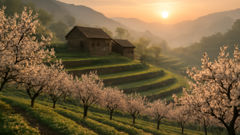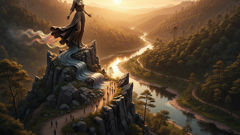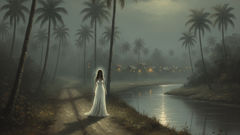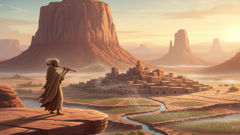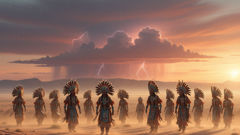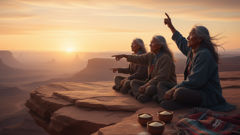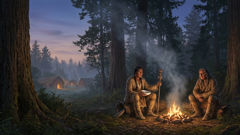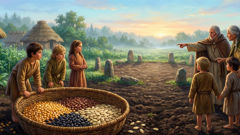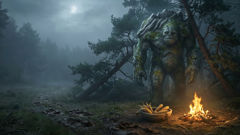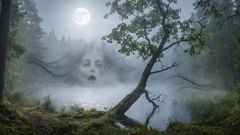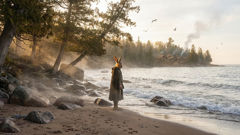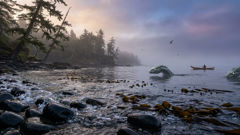Introduction
In the mornings, the air in Puerto Rico wears a damp, stubborn sweetness—the sort that clings to skin and memory, coaxing names from the mouth and keeping animals close to the heart. This is not merely a story about a creature; it is a map of a place where feet know every broken gate and every well-worn path between village and sea. The Chupacabra—the goat-sucker, as the old songs translate—has been a rumor, a night-swinging shadow, a rumor again, until it steps out from the margins of fear and into the center of conversation. Here, under a restless moon and the washed-blue light of dawn over the karst hills, a string of livestock killings unsettles the quiet rhythm of farms that have fed families for generations. Some blame the heat, others blame the dry season, a few point to misfortune and bad luck, but the oldest voices insist the danger is not new; it merely learned to wear different clothes in a new century. This novel approaches that ancient fear with patient curiosity, inviting readers to listen closely to whispers at the edge of a field, to the careful arithmetic of a veterinarian tallying wounds that don’t quite fit any known animal, to the chorus of neighbors who switch from coffee to questions as soon as the sun climbs above the coconut trees. The island itself becomes a living character: a chorus of waves at the shore, a council of cicadas in the palms, a town square that holds the memory of storms and the promises of markets after rain. The story is set not to prove or disprove a myth but to illuminate how a myth breathes when people choose to tell it aloud, in kitchens and radio studios, on dirt roads and in the glow of a cellphone screen. The tone remains intimate, intimate enough to feel the scratch of a pen on notebook paper, dramatic enough to carry the thunder of a storm, and hopeful enough to remind us that legends are also ladders—leading us toward a clearer view of who we are when we finally decide to look. This is a story about listening: listening to the past to understand the present, listening to fear to find a way through, and listening to the land to hear its truth about scarcity, resilience, and shared responsibility.
Section I: The Fence that Listens
The first signs arrive on a Tuesday that smells of rain yet doesn’t yield it. A farmer named Miro finds two goats with puncture wounds along the neck, clean and clinical, as if a blade had brushed against them and left only a trace of fear. The wounds don’t bleed; they don’t bite in obvious ways. There is instead a peculiar, almost surgical mark—perfectly small, edged with a sheen that makes the fur around it seem bruised by cold fire. The goats survive, but the life that was in their bellies feels faint, as if the animals have learned a secret that the farmer cannot decode. Miro’s wife, Rosa, swears she heard something in the night—soft and metallic, like coins being counted in a pocket, or wind over a tin roof. She had woken at the moment the first goat cried and the second fell silent. She did not see anything in the dark, only a sense that something had hovered, not long, but long enough to leave a chill trailing the memory of it. The village’s rumor mill, always hungry for the next syllable of fear, begins to churn. A traveling hunter passes through the town with a truck full of old posters advertising “exotic critters” and a stern warning etched in his handwriting: do not let livestock wander with the moon. He’s careful to remind everyone that a century of legends travels best when wrapped in the language of science, but his own notes carry more superstition than evidence. Maria, a wildlife journalist who has traded the bright, loud attention of the city for the quiet of countryside radio, begins to sense that the story might become something more than a series of livestock losses. She drives along the narrow roads, the car’s radio crackling with static and the soft, persistent rustling of sugarcane fields. Her microphone captures the whispers of the people who live between the edges of superstition and reason: a grandmother who remembers dark nights when the dogs howled in chorus with the storm; a teenager who posts theories online, half-excited, half-terrified; a veterinarian who speaks in terms of anatomy and appetite, as if the creature could be measured like a patient in a clinic. The goats’ wounds heal, but the memory does not. The fence becomes a listening thing, a wooden boundary that seems to absorb the fear of the night and where the heartbeat of the farm keeps time with the tides. At night, a shadow passes along that fence—a slender, quick silhouette that vanishes when light returns. The memory of it sticks to the skin like a small scab, hard to pick and easy to forget, until it isn’t. The section ends with a dog barking in the distance and a field bathed in a pale, uncertain light, and with a question that grows louder the more people try to tell it away: What is it that steps across the line between animal and myth, and who, if anyone, dares to name it?
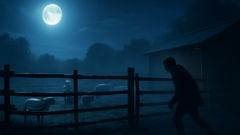
Section II: The Night Radio and the Tide of Questions
Maria’s radio show becomes a crossroads where science, fear, and faith converge. She announces a plan to host a live discussion with a veterinarian, a folklore scholar, a fisherman who claims to have seen strange lights over the bay, and a grandmother who insists the land remembers. The studio hums with the warmth of the old transmitter, its tubes glowing with a stubborn orange light that feels almost living, like a small, patient flame. The participants bring different languages to the same table. The veterinarian speaks in measurements and symptoms, describing the wounds with precise terms—punctures arranged along the neck, minuscule hemorrhages, the absence of torn tissue that would indicate a predatory attack. The folklorist, dusty with the scent of old libraries, recites episodes from village lore: the goat-lords of the mountains, the night-birds that feed on fear, the tale of a hunter who once tracked a ghost until dawn and found instead a family of owls in a hollow tree. The fisherman swears he saw something gliding along the edge of the sea—not land-walk, not fins, but something that moved with a liar’s certainty, as if it wore the truth like a mask. The grandmother sits with the quiet certainty of someone who has spoken in the dark to wind and to moon and has never once been proven wrong by her own memory. She tells a story about a thirst that travels across the land, a thirst not for blood but for stories, and for the certainty that people will watch over each other when the night grows dangerous. The discussion grows tense as new evidence surfaces: a farm hand posts a photo—the faint silhouette of a creature that might be a dog or a fox, but the shadows in the image refuse to settle, shifting with the angle of the lens and the gravity of fear. The town, drawn to the radio tower like moths toward a warm flame, asks questions about vehicles, about footprints in the mud, about the possibility of a misidentified wild dog or a disease that causes animals to hide their fear in a way that looks unfamiliar to us. The conversation shifts away from blame and toward responsibility. If a creature is real, what do we do with it? If it isn’t, what do we learn about ourselves from the way we tell its story? Maria hosts the night with a careful, generous tone, allowing voices to collide and then to harmonize. She closes the show with a line that feels like a soft, weathered rope thrown across a chasm: Fear can be a teacher if we learn to ask better questions, not merely to flee. The section closes on a coastline scene—salt air, the taste of brine, and the thought that the sea often knows more than the land does, and perhaps knowledge comes not from proof but from listening to what remains unsaid.
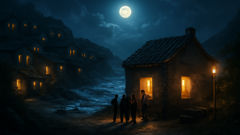
Conclusion
By the time the moon wears itself thin and drops low into the sea, the island has learned a few quiet truths. Myths don’t vanish with a census or a science report; they bend, they glow, they change their face to fit the questions we themselves cannot yet answer. The Chupacabra, if it is a creature at all, becomes something closer to a mirror: a reflection of what fear does when it travels faster than facts, a reminder that communities become stronger when fear is faced together, not fled from. The people of the island decide to maintain a careful, compassionate watch over their farms, their animals, and each other. They work together to strengthen pens, to document events with a discipline that respects both curiosity and caution, and to share resources so no family must bear the burden alone. The last pages of this story don’t claim certainty; they claim responsibility. They propose a future where legends are not used to justify cruelty or neglect but to awaken care—the kind of care that makes a neighbor check in across a fence line, that invites a stranger to sit at the same table and grow a little braver together. Whether the Chupacabra exists as a literal creature or as a legend born from the soil of fear, the people learn to live with the mystery, to let it tease the edge of reason while they walk the center with courage, in search of a truth that does not demand a specification of teeth or talons but a willingness to listen, to learn, and to protect what binds them to each other and to the land they call home.

